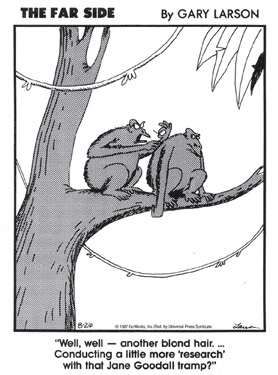Subscribe to Gorilla Grants
We regularly run grants to help researchers and lecturers get their projects off the ground. Sign up to get notified when new grants become available
Spotlight on...
November 2018
Kirsty Graham and Cat Hobaiter look at how non-human primates use gestures to communicate: Can human participants “understand” chimpanzee and bonobo gestures?
Kirsty was one of our first Gorilla Grants winner. Cat Hobaiter acted as Kirsty’s supervisor during her research. For this intereesting spotlight we interviewed both. Have fun reading!
We study how chimpanzees and bonobos use gestures to communicate – they use a set of around 70 gestures and many of the gestures share meanings for both species. Chimpanzees and bonobos are our closest living relatives, and given that they share so many of their gestures, we wanted to see if humans share them too. We used Gorilla.sc to test whether human participants “understand” chimpanzee and bonobo gestures.
In each round, participants watched a clip containing a chimpanzee or bonobo gesture and were given four options for what they thought the gesture means. The “correct” answer is the meaning it’s used for in chimpanzees and bonobos.
We’re still analysing our data, but one thing we do know is that it looks like our participants were above chance – so there’s definitely something that humans understand about ape gestures!
We found that the majority of great ape gestures seem to be biologically inherited – that makes them like many other animal signals (including ours!). It doesn’t matter who you are, all apes have access to the same species-repertoire of gestures, and closely related species share many — sometimes almost all — the same gestures too.
Some people interpret that as us saying ape gestures are fixed, or inflexible – but that’s not the case at all. Just like in human language, we have a biologically inherited foundation, which is incredible plastic through our ontogeny. You can take a ‘human-typical’ set of available phonemes and end up with languages as diverse as Chinese, Swahili, and French. The available gestures might be biologically inherited, but what young apes learn to do with them might turn out to be really flexible.
Not yet! We are planning to finish the article in October, then we will submit it and cross our fingers (we are gesture researchers, after all).
Online research can help us to reach demographics outside of the university. So many studies are limited to the students we can recruit from within the psychology department! Online research allows us to draw from a much larger and more representative pool of people.
Not at all – one of the plus points for us using Gorilla was the flexibility to set up our own consent forms, and debrief statements, and to recruit in a number of different ways. For example we could let under 12-year old participants play the application as a ‘game’ without collecting their data.
The School in St Andrews is a Psychology school, and they sent round an email about this new tool. Being honest I’m not sure it would have caught our eye if it wasn’t called Gorilla! But once we had a play with it we were hooked. We’ve never done any online citizen science research and Gorilla made it super easy.
“We recruited almost 15,000 participants!”
Oh wow – from our point of view the set up was really intuitive and customisable, and from the participant’s point of view it’s got a very accessible, comfortable interface. Through social media, radio, and online articles, we recruited almost 15,000 participants, and we would never have been able to reach that number without the Gorilla platform and the team behind it.
It was really neat starting to work with Gorilla as the platform was developing – there were a couple of occasions where we’d ask about a feature that was just coming out. One thing that would be really useful for outreach and for taking experiments to more remote areas would be the ability to download the experiment as an app that can be used offline. That way we could have it on touchscreens in museums or zoos as an interactive exhibit. Actually, we have heard that this is in the works, so watch this space!
Cat: I came to primatology almost by accident. I started out in Physics, but then took a Psych class early on and came across the idea that evolution had shaped not only our bodies but also our minds — that had me hooked!
Steven J. Gould because we could talk science and politics, and probably about the fact that the two are inseparable. And all the delightful and goofy stories about dinosaurs and evolution, of course.
It’s a generic one but get on to Twitter – there’s an incredible science community on there, and no matter how niche your subject there’s a twitter family for you. You don’t have to participate that much at first, just following your favourite researchers and institutions is a great way to keep in the loop on new papers, grants, and jobs. But if you feel like getting stuck in it’s also an incredible resource for connecting with both other scientists and non-science folk.
We swear there are two of us behind this interview, but we have so much overlap it sounds a lot like we’re just one person! When we’re both in the same place we enjoy hiking and rock climbing, and we’re plotting a surfing trip for the autumn when Kirsty is back from the field. And of course most of these adventures end in a pub, or on top of a mountain with Cat’s flask of whisky.
The Far Side cartoons by Gary Larson are amazing — there are so many good science ones, and even a couple of animal communication and field primatology ones!


We regularly run grants to help researchers and lecturers get their projects off the ground. Sign up to get notified when new grants become available